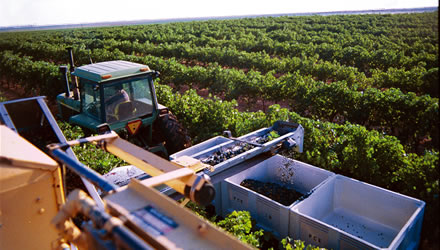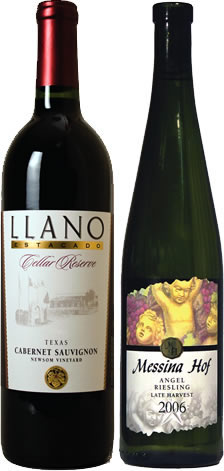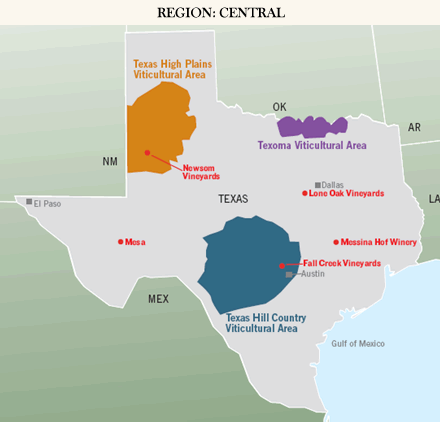
|
|
PRINT » |
|
|
E-MAIL THIS PAGE » |
|
|
CLOSE THIS WINDOW » |
Feature Article from the June 2008 Magazine Issue
Grape Supply Dilemma
Should Texas wineries pay higher local prices or buy from California?

Prendergast's figure of 4,500 tons really is optimistic. Texas is experiencing a chronic shortage of winegrapes, and in many years, grape production doesn't even come close to that level. In 2006 and 2007, late freezes and hail killed or maimed a lot of vines. Prendergast's winery is the perfect example: In good years, his vineyards produce more than half the winegrapes in Texas. Even at that volume, he has to buy half of his grapes from outside the state.
View Texas Map
The weather in 2006 and 2007 hit his vineyards hard. "After these two freezes the last two years, we've had to take a lot of blocks out," he says. "We'll get lower yields, plus we had to pull a lot of vines. This year, we'll get about 40% of our normal crops, so we're going to have to be buying a lot more grapes than we usually do, and Texas farmers can't provide what we need."
Neal Newsom is president of the Texas Wine and Grape Growers Association (TWGGA) and owner of Newsom Vineyards. His farm provides grapes to many of Texas' best wineries. He views the shortage issue from a farmer's perspective: "If everything that has been planted was in full production, we'd still be in a shortage," he says.
"All these wineries would prefer to be buying Texas grapes for their tier-one wines, and we're not even growing enough to fill that need. We currently have 3,600 acres planted to winegrapes in Texas. Just to support the tier-one wines would take 5,000 or 6,000 acres. That doesn't even count the under-$10 wines made by the big wineries like St. Genevieve, Llano Estacado, Fall Creek and Messina Hof. If they wanted to buy Texas grapes, we'd probably need 12,000 acres."
Growth compounds the problem
The grape shortage is compounded by the breakneck growth in the number of Texas wineries. "In 2003, we had 54 wineries and 3,600 acres of grapes. Today we have over 150 wineries, but we still have the same 3,600 acres of grapes that we had in 2003," says Gene Estes, owner of Lone Oak Vineyards and president-elect of TWGGA.
"It's especially difficult for new, small wineries like us. We opened in October 2006, and we are having to compete with wineries that have been around for years and have long-term contracts. So we're having to find new growers willing to expand their acreage." Since it can take up to four years after preparing the dirt to get good grapes, it will be a while before the farmers can provide the grapes that are needed.
The shortage creates another problem for the winery owners. When demand outstrips supply, prices escalate. Ed Auler owns Fall Creek Vineyards, one of the top five wineries by volume in Texas. He has a "big picture" viewpoint.
"There's no question we need more grapes," he says. "Texas has soils and climate that can produce world-class wines. But for the big wineries, to buy the $1,800-a-ton grapes, we have to be able to charge $18 a bottle. The small wineries can buy the grapes for that price and sell the wines in the tasting room and make a lot more profit than we can when we have to sell it to a distributor who sells it to a grocery store who puts it on a shelf next to California, Argentina, Chile and Australia wines. The top wineries need more grapes, but we need grapes that will translate into wine on the shelf at under $10." By Auler's reckoning, that means $900-$1,000 per ton, and no one in Texas is selling good grapes for that price.

Smaller operations feel the pain
Gene Estes represents the more common Texas winery: producing under 10,000 cases, with most wine sold direct-to-cons umer. "We are trying for minimal distribution in retail operations and are trying to emphasize our tasting room and wine club sales," he says. "Because of the supply shortage, Texas winegrapes are very expensive, even compared to buying them in California and shipping them here. Texas wineries are paying $1,500-$2,000 per ton. You can buy grapes from California for $400 per ton. If you want to stay in business and you can't get Texas grapes, you have to buy them elsewhere. We'd all like to be using Texas fruit. Texans are proud. The real challenge for us is to find ways to get current farmers to understand how profitable winegrapes are."
Neil Newsom says that many farmers still remember the bust of the 1980s. "Some of us old-timers remember the bust. It's like a bad hailstorm; you never forget it. The day after they announced the red wine paradox, suddenly our white grapes were worth $200 a ton, and a lot of the farmers weren't able to recover. Some lost the family farm over it. Of course, back then we had four wineries, and now we have over 150."
He's focusing TWGGA's efforts on two areas that would help the farmers feel more secure: getting grants from the Texas Department of Agriculture (TDA) to help farmers to make the transition to grapegrowing, and changing the three-tier system so that small wineries can sell directly to restaurants and stores.
How government can help
One of the reasons for the dramatic growth in the state's wine business has been the TDA's commitment to the industry's growth. Starting with the previous commissioner, Susan Combs, and continuing with the current commissioner, Todd Staples, the TDA has been moving state government toward helping both grapegrowers and winemakers by establishing useful programs and shepherding helpful laws through the legislature. They have been quick to recognize the current problems and to set some solutions in place.
While state government has not yet provided actual grants, it has committed to react quickly and get some help out to the farmers. "I'm excited about a new pilot program we are close to implementing that will encourage Texas growers to plant more acres of grapes," says TDA deputy commissioner Drew DeBerry. "We are really dedicated to supporting our grapegrowers and winemakers, to give them the tools they need to make Texas wines the toast of wine connoisseurs around the world."
Newsom is of two minds about government help. He welcomes the true help he's getting from the state Ag Department, and he hopes it won't take on the bureaucratic paper shuffle he sees in the federal government. He also believes that a number of other farmers are starting to pay attention.
"We all know the Farm Program is not going to last that much longer," he says of the federal program that subsidizes farmers who grow, or once grew, certain crops. More than 90% of the subsidies go to rice, wheat, soybeans, corn and cotton farmers. The program was designed to help save family farms, but most of subsidies end up in the coffers of huge agribusinesses.
Members of Congress have been trying to kill the program for years without success--but given the huge deficit at the federal level, many farmers believe that the program may indeed be ending. "Years ago, when I got into grapes, it was because I thought the Farm Program would become such a bureaucracy it wouldn't be worth fooling with," Newsom says. "I was just early to that party, because now everyone is looking for something else. The Farm Program is definitely going away."
Newsom is not alone in that belief. Plenty of farmers in the prime grapegrowing area of Texas' High Plains region measure their farms in sections, not acres. Newsom says help is on the way from these big farmers. "I think word is getting out," Newsom says. "We now have some full-time commercial farmers who are getting interested in growing grapes. They'll make a huge difference, both in the supply and the costs, but it won't be for a few years."
| Texas land prices are all over the map
In the Dallas area, land costs between $5,000 per acre in rural locales and $11,000 per acre for parcels closer to towns. Builders around Dallas have caught on to the fact that putting a vineyard in the middle of a housing development attracts upscale buyers, and the cost of that land is astronomical. The High Plains area is mostly farming and ranching country, and the values of land are as fluid as agricultural prices. Prices are up right now due to the demand for corn. Water is the big issue for frost protection, and land with a decent supply of water sells for $1,500 per acre. Farmers interested in growing late-blooming grapes that aren't so prone to frost damage can get good land for as little as $500 per acre. The Hill Country has the added benefit of being a tourist center and a magnet for wealthy Texans looking for ways to exercise their inner "gentleman farmer." Consequently, land prices there are the highest in the state. The area west of Austin is the priciest, with vineyard-suitable land selling for up to $25,000 per acre. The least expensive land for vineyards would be along the north edge of the Hill Country, from San Saba to Comanche, which costs around $5,000 per acre. W.M. |
Return to article

|
|
PRINT » |
|
|
E-MAIL THIS ARTICLE » |
|
|
CLOSE THIS WINDOW » |
